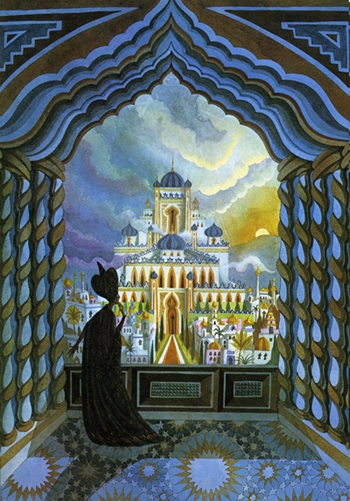Mythology in the Middle East
Jul 09, 2012

Illustration of 'Aladdin' by Errol Le Cain.
By Shamir Allibhai, Digital Department, DFI
At times, we need to remind ourselves that the Middle East has a rich history of mythology. These days it feels like we are just mainly importing and consuming Hollywood films and their myth-based stories. But this isn’t the case; we are just importing Hollywood’s interpretation. The stories, a lot of the time, are ours.
One of the most famous of these stories is ‘A Thousand and One Nights’, a fixture in the West’s imagination. From Aladdin and Ali Baba to Sinbad and Scheherazade, these rich characters plus their mystical flying carpets, magic lanterns and genies, are a pivotal part of the collection as we know it today. But it wasn’t always like this.
| Did you know: |
|
‘1001’ is first referred to in the 10th century in a massive and meticulous catalogue written by Baghdadi bookseller named Ibn Nadim. He refers to ‘1001’ as that which has been translated from an earlier Persian work known as ‘Thousand Stories’.
The Persian work was appropriated by Arab authors and added to. Changes to the collection by Arab authors included:
- New tales being added, many of which were drawn from the local oral story-telling tradition at the time
- New tales that were added were set in 9th century Baghdad and 12th – 14th century Cairo
- Most striking was the mention of particular rulers, places, buildings, and other items very specific to the time and place in which 1001 was evolving and being added to
In many ways, this is a repeating pattern in humanity where we appropriate myths and stories and project our own ideas, hopes, aspirations, struggles, and questions unto them. For example, in pre-Islamic times, even though rulers of Mesopotamia (where Kuwait and Iraq exist today) came and went often, the myths and gods remained similar. When one nation conquered another, conquered gods were often merged in their own mythology. This is why the Sumerians, Akkadians, Babylonians, Assyrians, and Persians of Mesopotamia shared many myths, borrowed stories from each other, revised and edited them, and connected one myth to another.
| Did you know: |
|
As had been done before, ‘1001’ was further added to, this time by the French and other Europeans. They did not appropriate the stories to make it their own but instead projected their stereotypes into new stories. French scholar Antoine Gallard translated and published ‘1001’, including incorporating the story of Sinbad which was not part of the original work, in 1704-1706. The public loved the book and they lapped up the fantastical tales. They demanded, voraciously, for more.
But there were no more stories. With the prodigious public demand and the lure of profits, the collection “grew” with subsequent releases. Some of these added stories are famous ones we best think of as ‘1001’ such as ‘Ali Baba and the Forty Thieves’ and ‘Aladin and the Magic Lamp’.
| Did you know: |
|
Do we ever really own a story? Maybe we all do and at the same time, maybe no one does. That the story of humanity is one in which we are bound by our passion for and gravitation to the story itself, which are constructed and added to over generations to help us make sense of our world and are a reflection of the state of our current society. Civilizations didn’t just exist in a vacuum: there were porous borders in which they were influenced by and did the influencing through arts, culture, and literature. The same is true today and it is important storytellers from the Middle East tell their own stories instead of letting anyone else tell it for them.
Even Persians cannot definitively claim original ownership over Scheherazade’s tales. Even before ‘1001’ was added to by the West, and it was Arab and Persian, it may actually have originated in India. Scholars say several stories in the collection have parallels in Sanskrit and the literary device of framing a story within a story was used in India even before it appeared in Persian or Arabic literature.
That just may make ‘1001’ one of the oldest global blockbusters.
In sum, the Nights is a fascinating case study of cultural contacts, translation, folklore and ‘fakelore’, ethnic stereotyping, European colonialism, Orientalism, and the influence of capitalism and marketing on the creation of culture. –Dwight F. Reynolds ‘Arab Folklore’ author
To read more about 1001 and folklore from the Middle East, see: Arab Folklore by Dwight F. Reynolds.